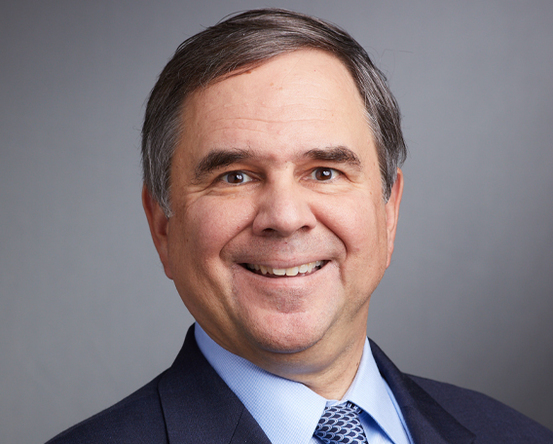Oncology
Advanced Hormone-Sensitive Prostate Cancer
High-Risk Locally Advanced Prostate Cancer: Session Roundup
Overview
Daniel P. Petrylak, MD, comments on advances in the management of high-risk locally advanced prostate cancer, touching on some of the related proceedings from AUA2021.
Featured expert Daniel P. Petrylak, MD, was interviewed by Conference Reporter Editor-in-Chief Tom Iarocci, MD, and Dr Petrylak’s perspectives are presented here.
Daniel P. Petrylak, MD
|
|
“We need well-controlled clinical trials to validate the optimal treatment pathway for patients with high-risk locally advanced disease.”
High-risk prostate cancer may occur in approximately 15% of prostate cancer diagnoses; however, definitions of high risk include a heterogeneous group of patients with a range of prognoses that can include lethal phenotypes. Features of high-risk and very high-risk disease have been proposed in contemporary guidelines, and the emergence of newer diagnostic, genomic, and imaging modalities have allowed for better disease risk stratification and patient-centered treatment strategies.
The diagnosis of high-risk and very high-risk advanced prostate cancer has been increasing in recent years. This was highlighted in an analysis of the Surveillance, Epidemiology, and End Results database presented at AUA2021 (abstract MP43-08). Wenzel et al found that the estimated percentage of high-risk and very high-risk prostate cancer increased by approximately 4% and approximately 9%, respectively, between 2010 and 2015. However, after adjustment for the number of prostate biopsy cores, there were no significant differences between the 2 time periods. The investigators found that these rates were strongly associated with the number of prostate biopsy cores, which they suggested may be driven by the broader use of magnetic resonance imaging.
Although the optimal treatment for men with high-risk locally advanced prostate cancer remains unknown, emerging data suggest that both radiotherapy and radical prostatectomy should be included in multimodal treatment regimens for patients with high-risk locally advanced disease, with the possible addition of postoperative radiotherapy and/or androgen deprivation therapy (ADT). This was highlighted in a real-world study evaluating the treatment patterns and the time to metastatic disease development of patients with high-risk nonmetastatic prostate cancer (abstract PD61-08). This study compared patients who received upfront ADT only, radical prostatectomy, radiation therapy, or both radical prostatectomy and radiation therapy. The study found that patients who received radical prostatectomy plus radiation therapy had a longer time to metastatic disease (89.5 months) compared with radical prostatectomy only (56.2 months), radiation therapy only (44.2 months), and ADT only (35.4 months). We need well-controlled clinical trials to validate the optimal treatment pathway for patients with high-risk locally advanced disease.
In terms of primary ADT, several presentations explored data with gonadotropin-releasing hormone (GnRH) agonists and antagonists. A newer oral GnRH antagonist is now available (ie, relugolix). Some data have suggested that antagonists may have less cardiovascular toxicity than agonists. The main takeaway from the presentation by Saad and colleagues at AUA2021 was that relugolix and leuprolide had similar efficacies in lowering testosterone to the castration range, with no differences in castration resistance-free survival (abstract MP24-07).
Another potential therapy for advanced prostate cancer is lutetium-177–prostate-specific membrane antigen–617 (177Lu-PSMA-617), a radiopharmaceutical that delivers radiation directly to cancer cells. In a preliminary open-label study involving only 7 patients, 177Lu-PSMA-617 was administered, followed by radical prostatectomy (abstract MP15-20). Researchers reported that the regimen was feasible, although prospective data are required. Preliminary data suggest that 2 177Lu-PSMA-617 treatments followed by radical prostatectomy can be safely applied to those with high-risk locally advanced prostate cancer.
References
Frumer M, Rosenbaum E, Kedar D, et al. Neo-adjuvant 177Lu-PSMA-I&T radionuclide in high-risk prostate cancer before radical prostatectomy: a feasibility trial [abstract MP15-20]. Abstract presented at: AUA2021; September 10-13, 2021.
Moris L, Cumberbatch MG, Van den Broeck T, et al. Benefits and risks of primary treatments for high-risk localized and locally advanced prostate cancer: an international multidisciplinary systematic review. Eur Urol. 2020;77(5):614-627. doi:10.1016/j.eururo.2020.01.033
Saad F, George D, Cookson M, et al. Relugolix vs leuprolide effects on castration resistance-free survival from the phase 3 HERO study in men with advanced prostate cancer [abstract MP24-07]. Abstract presented at: AUA2021; September 10-13, 2021.
Sandoval ML, Dohm A, Yamoah K. Management of early-stage metastatic prostate cancer: appraisal of locoregional treatments and radiation therapy, with or without immunomodulation. Endocr Relat Cancer. 2021;28(8):T109-T120. doi:10.1530/ERC-21-0073
Tang D, Shepherd D, Belli A, et al. Real-world treatment patterns and time to metastatic disease development of patients with high-risk non-metastatic prostate cancer [abstract PD61-08]. Abstract presented at: AUA2021; September 10-13, 2021.
Wenzel M, Würnschimmel C, Collà Ruvulo C, et al. Increasing rates of NCCN high and very high-risk prostate cancer vs. number of prostate biopsy cores [abstract MP43-08]. Abstract presented at: AUA2021; September 10-13, 2021.
Wenzel M, Würnschimmel C, Ruvolo CC, et al. Increasing rates of NCCN high and very high-risk prostate cancer versus number of prostate biopsy cores. Prostate. 2021;81(12):874-881. doi:10.1002/pros.24184
This information is brought to you by Engage Health Media and is not sponsored, endorsed, or accredited by the American Urological Association.







